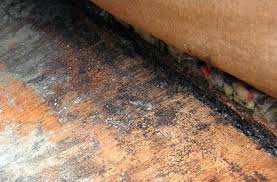Common Types of Mold

Whether allergenic, pathogenic or toxigenic, you should hire a professional to take care of the mold inside your home. However, you first must know which types there are and how you might recognize them.
1. AcremoniumAcremonium is a toxic carcinogen type of mold you will usually find in areas where there’s lots of condensation. This grey, orange, white or sometimes even pink mold often grows in humidifiers, window sealants, drain pans, and cooling coils. However, what’s even worse is that it can sometimes grow alongside other types of mold, for example, stachybotrys.
2. AlternariaWith brown and dark green hairs, as well as a velvety texture, Alternaria is an allergenic mold that usually grows in damp rooms. You’ll often find it in bathrooms, for example, under leaky sinks and in bathtubs and showers. Additionally, if there’s water damage, Alternaria will likely appear and lead to asthma-like symptoms.
3. AspergillusAspergillus is an allergenic type of mold that has flask-shaped spores and grows in thick layers. It has 185+ subtypes, which makes it tricky to recognize — it can appear in various colors. Just like other allergenic types, this one also causes asthma-like symptoms, lung infections, and even respiratory inflammation. Furthermore, certain subtypes can produce well-known carcinogens, such as aflatoxins.
4. AureobasidiumDo you have wooden or painted surfaces in your home, or perhaps wallpaper? If you do, you might also have aureobasidium mold. Usually, this mold has a pink, black or brown hue. However, as time passes, it can become much darker. Unlike some other types, this one can cause dermatitis if you touch it with your bare skin. Additionally, it often leads to eye, nail and skin infections.
5. ChaetomiumMoist and water-damaged areas are the favorite playground of Chaetomium mold. You’ll usually recognize it by its cotton-like texture, musty odor, and the color. It starts out as white but becomes grey, brown and even black later. Given that it leads to skin and nail infections, as well as the production of mycotoxins, this type of mold should be eliminated by removing moisture and repairing everything water might have damaged.
6. CladosporiumThough it’s not toxic, this type can irritate the skin, throat, nose, and eyes. Thus, it’s best not to touch it and instead get rid of it as soon as you notice it. Most often, it thrives indoors (whether it’s hot or cold) and grows in carpets, fabrics, and upholsteries. However, you may even notice its suede-like texture in cupboards and under floorboards too.
7. FusariumWhen there’s water damage, no matter if it’s cold or warm in the house, fusarium mold is likely to appear. This type of mold is both toxigenic and allergenic, and it’s often found in carpets and behind wallpaper, as well as in compost and on food. The good news is that it’s relatively easy to recognize. It is usually reddish, pink or white. Apart from allergic reaction symptoms (dermatitis and sneezing, for instance), this type can also lead to brain abscesses and bone infections. Additionally, it may produce toxins that are particularly dangerous for the nervous system. When left untreated, it can even lead to internal bleeding and hemorrhages.
8. MucorMost often, this greyish or white mold grows in thick patches and can cause asthma, as well as damage the respiratory system. Even worse, prolonged exposure could lead to a fungal infection called mucormycotic too. Thus, it’s crucial to check where moisture appears due to condensation in your home. You’re likely to find it near HVAC systems and AC units.
9. PenicillinYou’ll often see penicillin growing in water-damaged buildings. It is an allergenic type of mold that you can quickly recognize by its color; it’s either blue or green and has a velvety texture. Since it spreads fast, it’s crucial to eliminate penicillin from your home by checking all the most common areas it can appear, such as carpets, mattresses, behind wallpapers, and even near ducts. Otherwise, you could seriously damage your health. Penicillin leads to asthma and pulmonary inflammation, and it can even be the cause of chronic sinusitis.
10. StachybotrysAlso known as black mold, stachybotrys can cause allergic reactions and produce mycotoxins. It is a black or dark greenish mold with a slimy texture that loves growing on cellulose materials in damp areas with high humidity levels. Some of the most common symptoms in humans are heavy breathing, depression, fatigue, and sinusitis. However, it can cause neurological problems and even pulmonary bleeding too, especially when infants and children are exposed to it.
11. TrichodermaAlthough usually white, you can also recognize Trichoderma by its green patches. This mold grows quite fast on wet surfaces and in other moist parts of the house. It can also appear due to condensation build-up in HVAC system ducts and AC filters. Just like some other types, Trichoderma also releases mycotoxins and can lead to pulmonary and liver infections. What’s more, it can damage your home’s construction, as it has an enzyme that can eat away wood, paper, and textile.
12. UlocladiumUlocladium mold loves places where there’s lots of water, such as bathrooms, kitchens, and basements. Furthermore, it’s not uncommon to discover it around windows with high levels of condensation. With two subspecies, Ulocladium is dangerous and a sure sign there’s extreme water damage in your home. It can lead to skin infections, asthma-like symptoms, and severe reactions, for example, hay fever. Additionally, it often grows alongside other types of mold, like fusarium, Chaetomium, and stachybotrys.
By Mold Solutions
